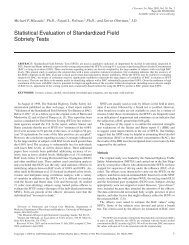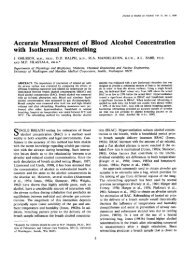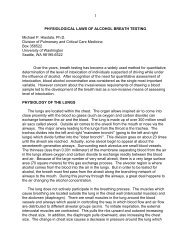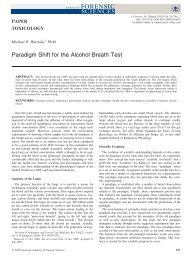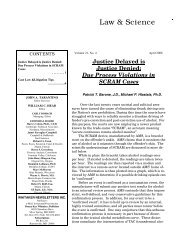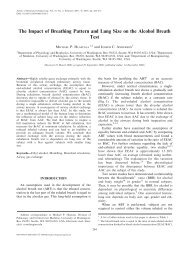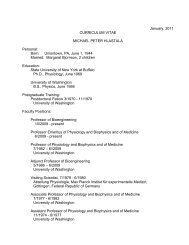1 THE SLOPE DETECTOR Michael P. Hlastala, Ph.D. Professor of ...
1 THE SLOPE DETECTOR Michael P. Hlastala, Ph.D. Professor of ...
1 THE SLOPE DETECTOR Michael P. Hlastala, Ph.D. Professor of ...
You also want an ePaper? Increase the reach of your titles
YUMPU automatically turns print PDFs into web optimized ePapers that Google loves.
<strong>THE</strong> <strong>SLOPE</strong> <strong>DETECTOR</strong><br />
<strong>Michael</strong> P. <strong>Hlastala</strong>, <strong>Ph</strong>.D.<br />
<strong>Pr<strong>of</strong>essor</strong> <strong>of</strong> <strong>Ph</strong>ysiology and Biophysics and <strong>of</strong> Medicine<br />
Division <strong>of</strong> Pulmonary and Critical Care Medicine<br />
Box 356522<br />
University <strong>of</strong> Washington<br />
Seattle, WA 98195-6522<br />
<strong>Ph</strong>one: 206 - 543 - 3166<br />
Email: hlastala@u.washington.edu<br />
The alcohol breath test is a single exhalation maneuver. The subject is asked to<br />
inhale (preferably a full inhalation to total lung capacity) and then exhale (preferably a full<br />
exhalation to residual volume) into the breath testing instrument. Very few restrictions<br />
(i.e., exhaled volume, exhaled flow rate, inhaled volume, pre-test breathing pattern, air<br />
temperature, etc.) are placed on the breathing maneuver. The constraints used vary<br />
among the different breath testing instruments and among the operators administering<br />
the test, and the level <strong>of</strong> cooperation <strong>of</strong> subjects, resulting in substantial uncontrolled<br />
variation in the precise maneuver used for the breath test.<br />
Slope detectors currently used on breath testing machines have two primary<br />
functions. One is to detect the presence <strong>of</strong> mouth alcohol by identifying a declining slope<br />
as the subject is exhaling. The other is to identify the presence <strong>of</strong> "alveolar air" so that<br />
an alveolar sample can be presumed. Unfortunately, neither <strong>of</strong> these features works as<br />
intended.<br />
In order to understand the slope detector problems, we must first purge from our<br />
thinking the notion that alcohol exchanges in the alveoli ("deep-lung" regions) <strong>of</strong> the<br />
lungs. Since the 1950's, it has been believed that the last part <strong>of</strong> the breath represents<br />
alcohol from the alveolar region, thus representing the blood alcohol by virtue <strong>of</strong> the<br />
blood-gas partition coefficient. However, computer simulation using basic gas exchange<br />
principles 1 has revealed that ethyl alcohol exchanges entirely within the airways <strong>of</strong><br />
normal human lungs. During inhalation, alcohol is picked-up from the airway mucosa<br />
(airway mucous surface), reaching equilibrium before reaching the respiratory<br />
bronchioles (the beginning <strong>of</strong> the respiratory gas exchange region). No further alcohol<br />
exchange occurs in the alveoli. During exhalation, some alcohol is redeposited on the<br />
airway mucosa. As expiration goes on, less alcohol is deposited on the airways, and<br />
more reaches the mouth, accounting for the increasing breath alcohol concentration as<br />
exhalation continues. Thus it is impossible to reach an alveolar plateau during a single<br />
breath exhalation because alcohol is always interacting with the airway mucosa.<br />
1
<strong>THE</strong> ALVEOLAR PLATEAU<br />
The lungs have a relatively complex, non-uniform, anatomical structure. The airways<br />
are a branching, tree-like arrangement <strong>of</strong> tubes. Inspired air moves through<br />
progressively shorter, narrower and more numerous airways (see <strong>Hlastala</strong> and Berger 2 ).<br />
These airways are lined with mucus at a temperature varying between approximately<br />
34 o C at the mouth and 37 o C in the very smallest airways. However, this temperature<br />
range varies depending on the breathing pattern 3 . The airways bifurcate up to 23 times<br />
and eventually reach alveoli. The membranes separating the air in the alveoli and the<br />
blood in the pulmonary capillaries are so thin that inert gases such as alcohol equilibrate<br />
between blood and air very rapidly. With exhalation, air within the alveoli is conducted<br />
along the airways to the mouth.<br />
During inspiration, air is heated and humidified as it passes through the upper<br />
airways 3,4 . Some water within the mucous layer or watery sub-mucous layer will<br />
vaporize and heat stored in the airways will be picked up by the inspired gas and taken<br />
to the alveoli. During exhalation, the process reverses; fully humidified air at core body<br />
temperature is cooled by the cooler airway mucosa and water vapor condenses on the<br />
mucosa. This water and heat exchange process is vital because it conditions the<br />
inspired air to avoid damaging the delicate alveolar cells while conserving water and heat<br />
from major loss in the exhaled air. Under normal environmental conditions, exhaled gas<br />
has less heat and less water vapor than does alveolar air.<br />
The dynamics <strong>of</strong> soluble gas exchange are similar to the dynamics <strong>of</strong> heat and water<br />
exchange. These processes are analyzed using analogous equations. The fact that<br />
respired air exchanges heat and water with the airways implies similar soluble gas<br />
exchange processes 5 . The degree <strong>of</strong> interaction is directly related to the solubility <strong>of</strong><br />
the gas in the airway mucosa and mucous lining. The very high solubility <strong>of</strong> alcohol in<br />
water guarantees its strong interaction with airway tissue. Because this interaction<br />
depends on temperature and airflow characteristics, variations in tidal volume and<br />
frequency can have a substantial effect on the alcohol concentration in the breath<br />
sample 6,7 . This variation is affected by the difference in temperature between the<br />
outside air and the alveolar air 8 .<br />
The early basic assumption <strong>of</strong> the breath alcohol test was that the breath alcohol<br />
concentration was the same irrespective <strong>of</strong> the exhaled volume as long as the dead<br />
space volume is exhaled. However, Jones 9 , and Ohlsson et al 10 have shown that the<br />
breath alcohol concentration depends on exhaled volume. The breath testing instrument<br />
takes a sample <strong>of</strong> air from the end <strong>of</strong> the breath whenever the subject stops but the<br />
volume <strong>of</strong> breath exhaled is neither controlled nor measured. Therefore, the apparent<br />
breath alcohol concentration depends on the volume <strong>of</strong> air delivered to the breath testing<br />
instrument.<br />
2
The achievement <strong>of</strong> a flat slope during exhalation has been presented as a<br />
demonstration that "alveolar air" with its alveolar alcohol concentration is obtained at the<br />
end <strong>of</strong> an exhalation. However, this hypothesis is incorrect in that a flat slope will always<br />
be obtained when expiratory flow rate approaches zero whether alveolar air is reached<br />
or not. In fact, the interaction <strong>of</strong> expired air with the airway mucosa during expiration<br />
prevents any sampling <strong>of</strong> alvolar air without a change in alcohol concentration. Figure 1<br />
illustrates a schematic example <strong>of</strong> an individual with a vital capacity <strong>of</strong> 6 liters who<br />
exhales into an alcohol breath testing instrument at a rate <strong>of</strong> 12 liters per second for a<br />
period <strong>of</strong> 30 seconds. The exhaled alcohol concentration rises until a plateau is reached<br />
after the end <strong>of</strong> exhalation (solid curve). If the same subject exhales for only 15<br />
seconds, then a plateau in<br />
alcohol concentration will<br />
also be achieved at the end<br />
<strong>of</strong> exhalation (dashed<br />
curve). But in this case the<br />
plateau value is lower. A<br />
plateau is reached in both<br />
cases, but neither<br />
represents a true alveolar<br />
sample. If it were possible<br />
for the subject to continue<br />
to exhale beyond his<br />
residual volume (minimum<br />
lung volume), then the<br />
exhaled alcohol<br />
concentration would<br />
continue to rise until<br />
alveolar alcohol<br />
concentration (as<br />
represented by<br />
rebreathing 10 ) were<br />
reached. As further<br />
evidence to this issue,<br />
BrAC<br />
gm/2 10L)<br />
.<br />
V<br />
L/ m in)<br />
Vol<br />
( L )<br />
10<br />
05<br />
00<br />
Figure 1.<br />
4<br />
2<br />
0<br />
6<br />
3<br />
0 second exhalation to 6 L<br />
10 20 30<br />
10 20 0<br />
0 0 0<br />
ime (sec)<br />
15 second exhalation to 3 L<br />
5 second exhalation to 3 L<br />
0 second exhalation to 6 L<br />
30 second exhalation to 6 L<br />
5 second exhalation to 3 L<br />
alterations in pre-test breath breathing pattern should not effect the end exhalation value<br />
if it is true alveolar air. However, hyperventilation decreases breath alcohol<br />
concentration while a breathhold increases breath alcohol concentration 6,10 . Endexhalation<br />
air cannot be in equilibrium with respect to alveolar alcohol concentration<br />
because the conditions <strong>of</strong> the airways affects the breath alcohol concentration.<br />
3
MOUTH ALCOHOL<br />
The detection <strong>of</strong> mouth alcohol does work as intended under some conditions. If an<br />
individual takes alcohol into the mouth, swishes it around and spits it out without<br />
swallowing, some alcohol will remain dissolved in the mucosal lining <strong>of</strong> the mouth. Then<br />
as he/she is blowing out into a breath testing machine, alcohol will be picked up as<br />
breath is passing through the mouth and an erroneously high breath test reading will be<br />
seen. Under normal conditions, during such a prolonged exhalation, the alcohol<br />
concentration first increases and then decreases. The detection <strong>of</strong> a decreasing slope<br />
by the breath testing machine is sufficient to register as an invalid sample due to the<br />
presumed presence <strong>of</strong> mouth alcohol. However, if the individual stops exhaling at just<br />
the point where the alcohol concentration reaches a maximum (before it starts<br />
decreasing), then the machine cannot distinguish this pattern from the normal exhalation<br />
pr<strong>of</strong>ile and will not identify the presence <strong>of</strong> mouth alcohol.<br />
There is another circumstance when the slope detector will not distinguish a<br />
contribution <strong>of</strong> mouth alcohol (Figure 2). If mouth alcohol is present in small quantities, it<br />
will add to the normal exhaled pr<strong>of</strong>ile <strong>of</strong> alcohol coming from the blood and alveoli. The<br />
result is that a small amount <strong>of</strong> alcohol (and its decreasing concentration) will be added<br />
to the normal exhaled pr<strong>of</strong>ile (and its increasing concentration) with a net effect <strong>of</strong><br />
producing a constant (or slightly increasing) alcohol concentration. The slope detector<br />
will not work correctly when alcohol is present both in the blood and the mouth. The<br />
measured BrAC will be higher than it should be. However, the slope detector will not<br />
detect the contribution <strong>of</strong> mouth alcohol.<br />
.125<br />
.100<br />
Mouth and Lung Alcohol<br />
Alcohol<br />
(gms/ 210 L)<br />
.075<br />
.050<br />
Lung Alcohol<br />
.025<br />
outh Alcohol<br />
0<br />
Figure 2.<br />
0 1 2 3 4<br />
Exhaled Volume<br />
liters)<br />
5<br />
4
IMPLICATIONS FOR <strong>THE</strong> ALCOHOL BREATH TEST.<br />
The slope detector, as used on current infrared alcohol breath testing machines, does<br />
not carry out the intended functions. The fact that different exhalation volumes result in<br />
different BrAC values demonstrates that the "alveolar plateau" function has no purpose.<br />
There never is any guarantee <strong>of</strong> "alveolar air". In fact, the physiology <strong>of</strong> the lungs<br />
guarantees that alveolar air cannot be sampled (for alcohol concentration) as it was<br />
when in the alveoli. The observation that the mouth alcohol function only works when<br />
there is no alcohol in the blood stream argues that mouth alcohol may be contributing to<br />
high BrAC values up to a 0.03 to 0.04 error (in the increasing direction) on any given<br />
test.<br />
5
FIGURE LEGENDS<br />
FIGURE 1. A schematic example <strong>of</strong> a subject with a vital capacity <strong>of</strong> 6 liters showing<br />
breath alcohol concentration (BrAC), exhaled air flow rate and exhaled air volume. The<br />
solid lines represent an exhalation at a rate <strong>of</strong> 12 liters per second for a period <strong>of</strong> 30<br />
seconds. The dashed lines represent an exhalation at the same rate for a period <strong>of</strong> 15<br />
seconds.<br />
FIGURE 2. Exhaled breath alcohol pr<strong>of</strong>iles. The lower curve is obtained with alcohol<br />
dissolved in the mouth with no alcohol in the blood. The middle curve is obtained with<br />
alcohol in the blood with no alcohol in the mouth. The top curve is the sum <strong>of</strong> the two<br />
other curves obtained with alcohol in the blood and alcohol dissolved in the oral mucosa.<br />
6
REFERENCES<br />
1. Tsu ME, AL Babb, EM Sugiyama and MP <strong>Hlastala</strong>. Dynamics <strong>of</strong> soluble gas<br />
exchange in the airways: II. Effects <strong>of</strong> breathing conditions. Respir. <strong>Ph</strong>ysiol.<br />
83:261-276, 1991.<br />
2. <strong>Hlastala</strong> MP and AJ Berger. <strong>Ph</strong>ysiology <strong>of</strong> Respiration. Oxford University Press.<br />
New York. 1996. pp. 318.<br />
3. McFadden ER, Jr. Respiratory heat and water exchange: physiological and clinical<br />
implications. J. Appl. <strong>Ph</strong>ysiol.: Respirat. Environ. Exercise <strong>Ph</strong>ysiol. 34:331-336,<br />
1983.<br />
4. Tsu ME, AL Babb, DD Ralph and MP <strong>Hlastala</strong>. Dynamics <strong>of</strong> heat, water and<br />
soluble gas exchange in the human airways: I. A model study. Ann. Biomed. Eng.<br />
16:547-571,1988.<br />
5. <strong>Hlastala</strong> MP and ER Swenson. Airway gas exchange. In: The Bronchial Circulation.<br />
Ed.: J. Butler. Exec Ed: C Lenfant. Marcel Dekker, Inc. pp 417-441, 1992.<br />
6. Jones AW. How breathing technique can influence the results <strong>of</strong> breath-alcohol<br />
analysis. Med. Sci. Law 22:275-280, 1982.<br />
7. George, SC, AL Babb and MP <strong>Hlastala</strong>. Dynamics <strong>of</strong> soluble gas exchange in the<br />
airways: III. Single exhalation breathing maneuver. J. Appl. <strong>Ph</strong>ysiol. 75:2439-<br />
2449, 1993.<br />
8. Jones AW. Effects <strong>of</strong> temperature and humidity <strong>of</strong> inhaled air on the concentration<br />
<strong>of</strong> ethanol in a man's exhaled breath. Clin. Sci. 63:441-445, 1982.<br />
9. Jones AW. Quantitative measurements <strong>of</strong> the alcohol concentration and the<br />
temperature <strong>of</strong> breath during a prolonged exhalation. Acta <strong>Ph</strong>ysiol Scand.<br />
114:407-412, 1982.<br />
10. Ohlsson J, DD Ralph, MA Mandelkorn, AL Babb and MP <strong>Hlastala</strong>. Accurate<br />
measurement <strong>of</strong> blood alcohol concentration with isothermal rebreathing. J. Stud.<br />
Alc. 51:6-13, 1990.<br />
7



